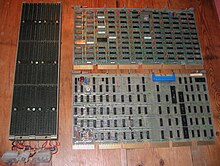| Unibus | |
 Unibus backplane (left) and two expansion cards | |
| Year created | 1969 |
|---|---|
| Created by | Digital Equipment Corporation |
| Width in bits | 18 address, 16 data |
| Style | Parallel |

The Unibus was the earliest of several computer bus and backplane designs used with PDP-11 and early VAX systems manufactured by the Digital Equipment Corporation (DEC) of Maynard, Massachusetts. The Unibus was developed around 1969 by Gordon Bell and student Harold McFarland while at Carnegie Mellon University.[1]
The name refers to the unified nature of the bus; Unibus was used both as a system bus allowing the central processing unit to communicate with main memory, as well as a peripheral bus, allowing peripherals to send and receive data. Unifying these formerly separate busses allowed external devices to easily perform direct memory access (DMA) and made the construction of device drivers easier as control and data exchange was all handled through memory-mapped I/O.[2]
Unibus was physically large, which led to the introduction of Q-bus, which multiplexed some signals to reduce pin count. Higher performance PDP systems used Fastbus, essentially two Unibusses in one. The system was later supplanted by Massbus, a dedicated I/O bus introduced on the VAX and late-model PDP-11s.
- ^ Gardner Hendrie, Interviewer (June 23, 2005). "Bell (Gordon) Oral History". Reference number: X3202.2006. Computer History Museum. Retrieved May 20, 2011.
{{cite web}}:|author=has generic name (help) - ^ "PDP-11 Buses". University of Sydney. Archived from the original on 2020-02-16. Retrieved 2020-04-30.